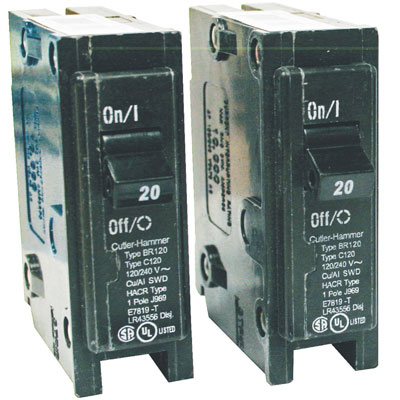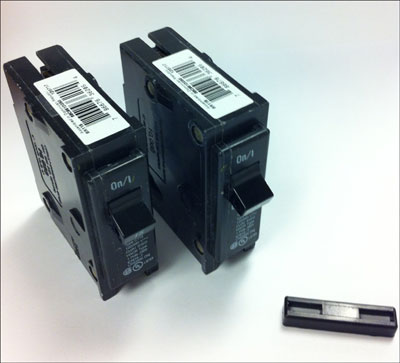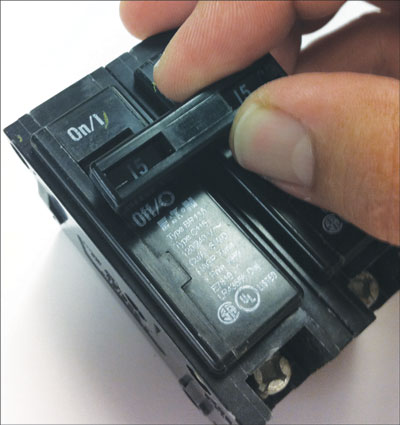Think back one or maybe more years ago when you had to assemble that latest purchase in front of the Christmas tree; picture the moment, if ever, you decided to open the assembly instructions and read them. It could have been before you got started — as you were drinking your coffee looking at the box and all of the parts. Or perhaps it was half way through when you couldn’t figure out how two parts went together. If you’re anything like me, it was when you were all done and you had a handful of parts left over. When it comes to electrical products, no matter how simple or how many times you’ve installed them, reading the labels on the products and the instructions can go a long way for electrical safety. Familiarity can indeed breed contempt in this arena. Today we’ll focus on slash-rated and non-slash-rated breakers and their applications.
This is an important topic as code requirements have driven more use of handle ties. Two 1-pole circuit breakers can be tied together with an approved handle tie but close attention to the markings and listing of the products is important to ensure they are not applied outside of their rating. Observing labels and understanding what they mean is an important first step.

Photo 1. 1-pole thermal magnetic circuit breakers rated 120/240V
Slash Ratings
The UL white book, in the “Marking and Application Guide – Molded Case Circuit Breakers,” which is available at www.ul.com/whitebook helps us understand the markings of circuit breakers. The General section, Item 3 entitled “Voltage Rating” illustrates that all breakers are required to be marked with their voltage rating. This marking is important to the proper application of these products, to ensure they are not applied at a voltage outside of their rating. All UL 489 Molded Case Circuit Breakers are marked with a voltage rating chosen from the following:
DC Voltage Ratings:
60, 125, 125/250, 160, 250, 500 and 600 volts
AC Voltage Ratings:
120, 127, 120/240, 240, 277, 347, 480Y/277, 480, 600Y/347 and 600 volts

Photo 2. Two 1-pole breakers and an approved handle tie before assembly
This reference identifies the existence of breakers that can be designated with a single voltage rating or a slant (or slash) voltage rating. A circuit breaker that carries a single voltage rating is intended for use in circuits where the circuit voltage and the voltage to ground do not exceed the voltage rating of the breaker. A slash-rated breaker, such as 120/240 V, is intended to be used in circuits where the circuit voltage does not exceed the higher of the two voltages and the voltage to ground does not exceed the lower of the two voltages. This reference notes the following when it comes to a slash-rated breaker:
“Two-pole independent-trip breakers and single-pole breakers with handle ties that are rated 120/240 V ac have been investigated for use in line-to-line single-phase circuits or line-to-line branch circuits connected to 3-phase, 4-wire systems, provided the systems have a grounded neutral and the voltage to ground does not exceed 120 V.”
A peek into UL 489 provides an understanding of what extra testing and requirements a slash-rated breaker must endure to qualify for this slash rating. Section 6.1.5 entitled “Operating Mechanism” includes Section 6.1.5.3 stating the following:
“6.1.5.3 Single-pole circuit breakers rated at 120/240 V ac or 125/250 V dc shall have provision for the use of handle ties. Handle ties, when installed, shall:
a) Operate both circuit breakers when either circuit breaker handle is manually operated;
b) Not be readily removable; and
c) Not obscure the ampere marking on either circuit breaker.”
These important physical requirements/qualities of an approved handle tie illustrate what an approved handle tie means physically for a circuit breaker. Section 7 of this same UL standard covers the performance based testing for breakers with the handle tie in place. Section 7.1.1.12 is specific for single-pole breakers rated 120/240 V. I’ll note here that most single-pole breakers that we encounter on residential systems, as depicted in figure 1, are slash-rated in this manner. This permits the use of approved handle ties in the field in cases where a contractor decides to “share the neutral,” a practice some electrical contractors employ to reduce the amount of wire required for home run circuits. Section 7.1.1.12 identifies the testing that must be performed on these single-pole slash-rated breakers as follows:
“7.1.1.12 If a single-pole circuit breaker is rated at 120/240 V ac or 125/250 V dc, see 6.1.5.3, two such circuit breakers shall be tested together in the intended manner as a 2-pole independent-trip circuit breaker in the overload, endurance, interrupting, and dielectric voltage-withstand test described below. Two such ‘pairs’ of circuit breakers constitute a set.”
When two 1-pole breakers are combined via an approved handle tie, they must both be slash-rated breakers. This ensures that proper testing has been performed on the “pair” of breakers for their application. Even if applied on only single-phase circuits, as is the case of shared neutral applications, this “pair” of breakers may be called upon to interrupt a line-to-line fault, a condition for which they have not been tested if they are rated 120 V only. The above introduces the term independent-trip which operates such that any single breaker in the pair of combined breakers may trip without causing the trip of the other breaker(s). This can be the result of applying an approved handle tie to two 1-pole breakers. Handle ties have become more popular these days due to recent National Electrical Code (NEC) changes.

Photo 3. Applying the handle tie to two 1-pole breakers. Note that the ampere rating on the handle will be visible after the application of the handle tie.
Shared Neutral Applications
The shared neutral application is familiar to many electrical contractors as sharing the neutral on the home run circuit from the breaker to first outlet can be one way of reducing material costs. Those applications where you would have pulled two 2-conductor (+ ground) wires instead are pulled with a single 3-conductor (+ ground) wire. Section 210.4 of the NEC addresses multiwire branch circuits noting that these circuits are those where all conductors originate from the same panelboard or similar distribution equipment.
An approved handle tie applied to two single-pole breakers for such applications as shared neutral installations ensures the installation meets the requirement of section 210.4(B), “Disconnecting Means,” of NEC 2011 which states:
“(B) Disconnecting Means. Each multiwire branch circuit shall be provided with a means that will simultaneously disconnect all ungrounded conductors at the point where the branch circuit originates.”
Section 210.4(B) does not require the breaker to disconnect all ungrounded conductors in the case of a trip. A breaker that operates such that only that pole which experienced the overcurrent trips while the other doesn’t is termed as an independent trip type of device. This section, rather, requires that when you turn the breaker to the off position all poles are turned to the off position. It is important to note that the construction of the breaker and the position to which the handle moves in the tripped state plays an important role on whether or not the breakers are independent trip. Some breakers trip to center. Applying an approved handle tie to two of these breakers may result in independent trip functionality as without an internal link between the two breakers, a single handle itself tripping to center may not pull the handle of the second breaker to the off position. The functionality of tripping both or all poles due to one single-pole seeing a fault, if present, is a common trip type of two pole device. Due to the internal linkages on these devices they are manufactured to ship as a two pole device. The manufacturer’s literature will indicate how the device operates, independent or common trip.
Applying the Approved Handle Tie
Care must be taken when applying an approved handle tie to two single-pole breakers in the field. As stated earlier, the practice of doing this was made easy due to the fact that most single-pole breakers you work with in residential systems are slash-rated. Sometimes the fact that most are slash-rated can lead toward a violation due to not reading the labels and checking. I guess this is a good example of the age old phrase “familiarity breeds contempt.” Before you apply an approved handle tie, you must verify that the breaker carries the slash-rating for the application and ensure that the handle tie is approved for use on that breaker. The manufacturer’s literature can be helpful and the label check is even easier. Looking for the slash-rating is a great first step for success.
There are single-pole breakers on the market that are not slash-rated. The ground-fault circuit interrupter (GFCI) and arc-fault circuit interrupter (AFCI) breakers are two examples. GFCI breakers provide a technical reason why the use of single-pole breakers in a shared neutral application, with an approved handle tie, is problematic. This is due to the fact that the breakers need all of the current that goes out on the hot to come back on the neutral. These devices act to trip the circuit if the current going out on the black wire (hot) does not equal the current that comes back on the white wire (neutral). Sharing the neutral with two GFCI breakers with this construction will result in instant tripping the moment a load on either breaker is energized.
Single-pole AFCI breakers on the market today, to the author’s knowledge, also carry a single voltage rating of 120 volts. Applying two 120V rated (NOT 120/240V) single-pole AFCI devices with an approved handle tie to serve shared neutral loads would be applying these devices outside of their rating. The bottom line for applying an approved handle tie to any pair of 1-pole breakers is to check the label for the slash rating. Slash-rated breakers are available, even for GFCI and AFCI circuits.

Photo 4. Final assembled 2-pole breaker with handle tie applied and approved
National Electrical Code Requirements
The NEC is not silent when it comes to handle ties and their application as discussed above. The various sections in the NEC that address this topic can stand for a little improvement but the requirements that align with the UL standards are there. Let’s explore this topic with respect to the NEC and I trust you’ll see what I mean.
The key sections in NEC 2011that are important for this discussion include the following:
Article 210 Branch Circuits
210.4 Multiwire Branch Circuits
210.4(B) Disconnecting Means
Article 240 Overcurrent Protection
240.15 Ungrounded Conductors
240.15(B)(1) Multiwire branch circuits
240.85 Application
Our first stop is going to be in Section 240.85, Application. This section is within Part VII of Article 240 which focuses on circuit breaker overcurrent protection. The language in this section mirrors that which is in the Marking and Application Guide for Molded Case Circuit Breakers found in the 2012 version of the UL White Book which was previously referenced in this article. Section 240.85 states the following:
“A circuit breaker with a straight voltage rating, such as 240V or 480V, shall be permitted to be applied in a circuit in which the nominal voltage between any two conductors does not exceed the circuit breaker’s voltage rating. A two-pole circuit breaker shall not be used for protecting a 3-phase, corner-grounded delta circuit unless the circuit breaker is marked 1φ–3φ to indicate such suitability.
“A circuit breaker with a slash rating, such as 120/240V or 480Y/277V, shall be permitted to be applied in a solidly grounded circuit where the nominal voltage of any conductor to ground does not exceed the lower of the two values of the circuit breaker’s voltage rating and the nominal voltage between any two conductors does not exceed the higher value of the circuit breaker’s voltage rating.”
This section provides guidance to help with the proper application of the product within its rating. It offers a simple check to ensure that you don’t exceed the rating of the device — measure the voltage between any two conductors. Let’s use a shared neutral application for this discussion (figure 1). Figure 1 illustrates the terminations in a shared neutral application where two 1-pole breakers have had an approved handle tie applied in the field. Measuring the voltage between any two conductors yields a maximum voltage potential reading of 240V between H1 & H2. If both or any single 1-pole breakers were rated only 120V, a violation of section 240.85 would result.
Section 240.15(B) is another area of the NEC that provides guidance for the application of handle ties. 240.15(B)(1) language is not specific on the voltage rating requirements of the two 1-pole breakers being handle tied. This section simply permits an approved handle tie to be applied in the field. 240.15(B)(2) does specify the voltage rating of the breakers handle tied for line-to-line connected loads. It is possible for one to mistakenly assume that two 1-pole breakers rated 120V may be handle tied as long as they are supplying single-phase line-to-neutral loads based on the words in these two sections. This would be in error, though, as other sections of the Code and UL requirements mentioned above help us to understand the proper application of these devices.
Section 240.15 has seen considerable changes over the years. Previous editions of the NEC, going at least back to the 1987 version of the Code, saw this “Ungrounded Conductors” section as 240-20. 240-20(B) in NEC 1987 read as follows:
“(B) Circuit Breaker as Overcurrent Device. Circuit breakers shall open all ungrounded conductors of the circuit.”
This had one exception:
“Exception: Individual single-pole circuit breakers shall be acceptable as the protection for each ungrounded conductor of 3-wire direct-current or single-phase circuits, or for each ungrounded conductor of lighting or appliance branch circuits connected to 4-wire, 3-phase systems or 5-wire, 2-phase systems, provided such lighting or appliance circuits are supplied from a system having a grounded neutral and no conductor in such circuits operates at a voltage greater than permitted in Section 210-6.”
This verbiage was in place, for the most part, at least as far back as NEC 1962. This section saw considerable changes in NEC 1993, NEC 1996, NEC 2005 and NEC 2011. It was in NEC 2008 that the section went from 240.20 to 240.15.
NEC 1990 introduced section 240.83(e), Voltage Marking. This section stated the following: “Circuit breakers shall be marked with a voltage rating no less than the nominal system voltage that is indicative of their capability to interrupt fault currents between phases or phase to ground.” This section also included a Fine Print Note (FPN) as follows:
“A circuit breaker with a straight voltage marking, e.g., 480V, may be applied in neutral grounded systems or grounded wye or grounded and ungrounded delta systems. Circuit breakers with slash voltage markings, e.g., 480Y/277V, 120/240, may be applied only in grounded neutral systems.”
This section ultimately ended up being split between 240.83(e) and a new 240.85, Application, section which was added in NEC 1996. This section has seen some changes since to better clarify the proper application of a circuit breaker.
This review illustrates an important aspect of the NEC — in some cases, many different sections of the Code work together to ensure a safe installation. When you think you have found the answer to your question quite easily, look a little harder; you just may learn something more.

Figure 1. Shared neutral termination on two 1-pole breakers with handle tie. The voltage between any two conductors cannot exceed the rating of the breaker (240.85).
Summary for Safety
We’ve talked a lot so far about ratings, UL requirements for single-pole and two-pole devices and the NEC. Let’s provide a quick overview via the following bulleted items:
- A circuit breaker that carries a single voltage (120V) rating is intended for use in circuits where the circuit voltage and the voltage to ground do not exceed the voltage rating of the breaker. You cannot apply an approved handle tie to these breakers.
- A slash-rated breaker, such as 120/240, is intended to be used in circuits where the circuit voltage does not exceed the higher of the two voltages and the voltage to ground does not exceed the lower of the two voltages. Single-pole breakers with slash ratings can have approved handle ties applied for shared neutral applications.
- GFCI single-pole devices only rated 120V cannot have an approved handle tie applied. This not only is a UL violation but also results in instant tripping of the device. For those shared neutral applications, 2-pole 120/240V rated GFCI breakers are available.
- AFCI single-pole devices rated 120V cannot have an approved handle tie applied. This is a violation of the UL listing and for those shared neutral applications 2-pole 120/240V rated AFCI breakers are available. Should a 1-pole AFCI carry a 120/240V rating, an approved handle tie may be applied for shared neutral situations.
The bottom line in the application of an approved handle tie is to read the labels and the manufacturer’s instructions to ensure you are not applying the product outside of its rating.
As always, keep safety at the top of your list and ensure you and those around you live to see another day.







Find Us on Socials